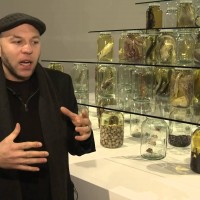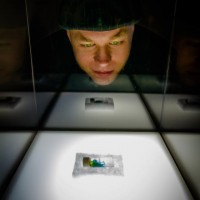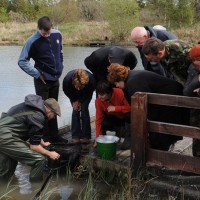Wearable Art: Artist/Biologist/Environmental Activist Brandon Ballengée Dresses For His Craft
This week, Brandon Ballengée, artist/ biologist/environmental activist, is preparing to transform the Feldman Gallery booth at The Armory Show into a space to mourn the massive extinction of species. It’s an incredibly weighty topic, often referred to as the Holocene or Sixth Great Extinction, which continues at an alarming rate. In promotion of this important showcase, called “Frameworks of Absence,” I requested to interview Ballengée, asking him to share with Art for Progress his favorite personal fashion items. After hesitating, Brandon said “oh well, that would be fun!”
Pioneering in ecological art, Ballengée has been described by the critic and curator Kim Levin “as taking these issues to a new level of intensity.” His work has been included in Documenta 13 (Germany), Prospect 2, (New Orleans), 3rd Moscow Biennale (Russia), Biennale for Electronic Arts, (Australia), and the Venice Biennale (Italy). And, Ballengée was awarded a Conservation Leadership Fellowship from the National Audubon Society’s Together Green Program in 2011-2012. “Frameworks of Absence” features physically cut images of missing animals from historic prints and publications printed at the time in history when the depicted species became extinct. A portion of proceeds from Ballengée’s “Frameworks of Absence” will support the Natural Resources Defense Council’s (NRDC) efforts to defend and protect endangered wildlife and wild places. To find out more about this thrilling exhibition, go to: BrandonBallengee.com
In the meantime, click on link below to discover more about this amazing environmental artist’s most prized fashion items after the jump.
Jacqueline Colette Prosper, @yummicoco
EVERYDAY HAT
In the middle 2000s, I stumbled across a great hat store in Italy. I was never really a hat person, but after trying one on, it just felt completely natural. For more than a decade, I have almost never been without a hat. I lost the Italian one in a jungle in Costa Rica a couple of years later, but found the exact same hat (same Italian brand/model/everything) at a great old-school hat shop in NYC after I got home. I lost that one a few years later in a bayou in Louisiana. Now, I am on my third hat (same style) and hope to keep it for a while longer, or until I inevitably jump into a swamp to chase a frog or alligator, and lose that one too.
T-SHIRTS
My everyday attire is a classic t-shirt with a vintage or contemporary French or Spanish dress jacket (black, gray, or pin stripes), black pants, and Italian dress shoes (I adore Italian dress shoes). Growing up, I was really into animals, science fiction, music and comic books. Since pretty early on, I have been wearing and collecting tees. I have great ones from natural history museums around the world, snake museums, herpetology (the scientific study of amphibians and reptiles) conferences, 90’s comics and bands. It’s hard to pick one favorite tee but top five would have to be: 1) a Cure one from 1986, 2) a Sandman one from 1989, 3) a Deadworld one from 1988, 4) a “frogs of the world” from 1992 at the first herp conference I attended, and last, 5) a rare white Coil shirt from 1994. But, I also really love my vintage Hellboy, “Save the Frogs,” X-men, Natural History Museum London, Misfits–it’s all too hard to pick.
WADERS
Waders or hip waders are standard field gear for scientific wetland studies that you wear over pants to keep them dry. Essentially, they are boots that go to your waist in order to be able to wade in water to collect frogs, fish or other aquatic creatures. Wearing them is great because it means I am out in nature doing what I love, exploring these amazing biodiverse and fragile ecosystems. I am an amphibian biologist, studying this important group of ancient and environmentally sensitive animals. Sadly upwards of 41% of known amphibian populations have declined or disappeared within the last 30-40 years. It is a total crisis. A world that cannot support them will not be able to sustain many other species, maybe even our own. So trying to understand why they are disappearing and how to stop this is really important. As an artist, my work relates to these experiences of being in nature and the huge loss of species we are seeing globally. To protect the amphibians I study, a new set of waders is required in every region of the world where the work is taking place (for example southern Netherlands, middle France, southern Quebec). There are several emerging and fatal diseases now in amphibians, and I want to make sure not to spread these accidently among varied populations, so I use one set of waders for each study. However, instead of throwing them away, I give them to local schools or environmental groups provided they keep using them in the same places for their field trips. Over the years, a few Museums have asked me to sign them and they keep them as artifacts of the projects.
A funny thing happened about ten years ago, I was wearing waders while doing a fish and amphibian survey with kids in Yonkers NY. While netting up fish in waders, I bent down to move a large rock and heard a loud tearing sound. It was then that I realized that my pants had spilt right down the middle. No one but me could tell because I had the waders over the now destroyed pants. The problem was I had forgotten to bring an extra pair of pants so I was literally trapped in the waders. I had to wear the waders back on the MTA train to Times Square in order to find somewhere to buy pants. Walking on 42nd street in waders was an experience! Tourists thought it was some kind of performance art and kept asking to take pictures with me, which of course I did. Someone even tried to tip me. I wonder if these photos are online somewhere…I should have taken those tips!
Jacqueline Colette Prosper, @yummicoco





